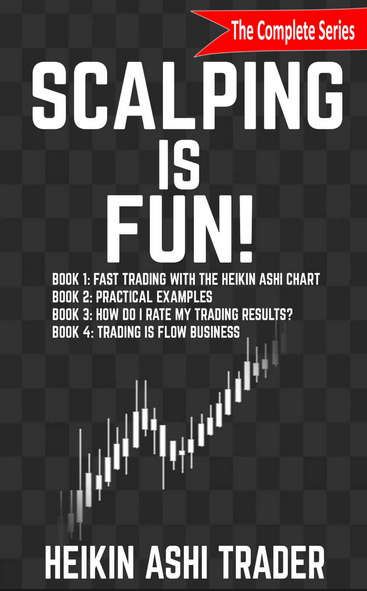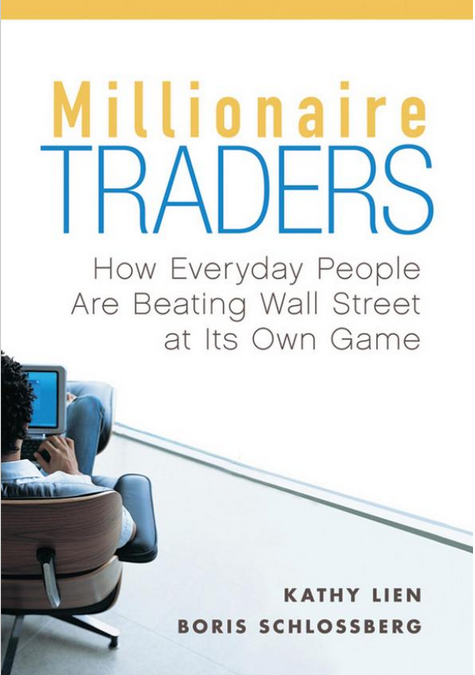You are missing trading opportunities:
- Free trading apps
- Over 8,000 signals for copying
- Economic news for exploring financial markets
Registration
Log in
You agree to website policy and terms of use
If you do not have an account, please register
Amazon's Top 10 Free Forex Ebooks
https://www.amazon.com/gp/bestsellers/digital-text/154876011?tf=1/ref=pd_zg_hrsr_digital-text
Scalping is Fun! 1-4: The Complete Series

Book 1: Fast Trading with the Heikin Ashi chart1. Welcome to scalping. Itís fun!
2. How do markets function?
3. What is trading?
4. What is scalping?
5. The Heikin Ashi chart
6. The scalping setup
7. Risk and Money Management
8. Make a decision!
Book 2: Practical Examples
1. Scalping with Technical Analysis
2. How do I Interpret Heikin Ashi Charts?
3. When do I Get In?
4. When do I Get Out?
5. Working with Price Objectives
6. Heikin Ashi Scalping in Practice
7. Does Technical Analysis Help While Heikin Ashi Scalping?
A. Support and Resistance
B. Swing High and Swing Low of the Past Days
C. The Importance of the Round Number in Forex
8. How do I Recognize Trend Days?
9. How do I Scalp Trend Days?
10. Conclusion
Book 3: How Do I Rate my Trading Results?
1. The Trading Journal as a weapon
2. The first 12 weeks of a new Scalper
- Week 1
- Week 2
- Week 3
- Week 4
- Week 5
- Week 6
- Week 7
- Week 8
- Week 9
- Week 10
- Week 11
- Week 12
3. How is Jenny doing now?
4. Scalping is a Business
Book 4: Trading Is Flow Business
1. Only Trade When it's Fun
2. When Not to Trade
3. The Best Trading Hours For:
A. Forex Traders
B. Index Traders
C. Crude Traders
4. Why Fast Scalping is Better than a Few Well-considered Trades
5. Discipline is Easier in Flow
6. Warning and Control Instruments
7. When You Win, Be Aggressive and Be Defensive When You Lose
I'm planning to read this... Is this a good one?
Forum on trading, automated trading systems and testing trading strategies
Something Interesting to Read December 2013
Sergey Golubev, 2013.12.25 08:14
Expert Advisor Programming for Metatrader 5: Creating Automated Trading Systems in the Mql5 Language (Paperback)
The first guide to programming in MQL5 is here! "Expert Advisor Programming for MetaTrader 5" is a practical guide to creating automated trading strategies in the MQL5 language. Take advantage of MetaTrader 5's new features and take your trading to the next level! You'll learn how to program expert advisors quickly and easily using a ready-made framework created by an experienced MQL programmer. This book will teach you the following concepts: Learn the basics of MQL5, including variables and data types, operators, functions, event handlers, and object-oriented programming. Place, modify and close market and pending orders. Calculate, verify and add stop loss and take profit prices to an open position. Add a flexible trailing stop and/or break even stop to your strategy. Manage your trade risk with money management. Use pending orders to scale in and out of positions. Use price, time and indicator data in your expert advisors. Control program execution by trading on new bar open, and add flexible trade timers to your strategies. Walk through the creation of several basic trading strategies from start to finish. Inform the user with dialog boxes, email alerts, mobile notifications and sounds. Draw trend lines, arrows and text labels on the chart. Read and write data to CSV files. Learn the basics of creating indicators, scripts and libraries in MetaEditor. Debug, test and optimize your trading strategy. And much more! Whether you're an experienced programmer moving from MQL4, or a novice just starting with MQL5, this book will give you the foundation to quickly program fully-featured and robust trading systems. All programs and source code files featured in the book are available for download at the book's official website at Expert Advisor Programming for MetaTrader - MQL4 and MQL5 book
Simplifying Forex: Beginner to Professional in 3,000 words by Diego Jose Villegas Delgado
This book contains all that is needed to understand the Forex market and simplifies the learning process of currency trading online.
From a professional perspective based on years of experience, analyzes the factors that generate reliable investment opportunities and guidelines to follow for beginners can develop quickly, genuine trading systems able to dominate the world's biggest financial market.
The Mental Game of Trading by Jared Tendler
Very good book!
Millionaire Traders: How Everyday People Are Beating Wall Street at Its Own Game
by Kathy Lien

Trading is a battle between you and the market. And while you might not be a financial professional, that doesn't mean you can't win this battle.Through interviews with twelve ordinary individuals who have worked hard to transform themselves into extraordinary traders, Millionaire Traders reveals how you can beat Wall Street at its own game.Filled with in-depth insights and practical advice, this book introduces you to a dozen successful traders-some who focus on equities, others who deal in futures or foreign exchange-and examines the paths they've taken to capture considerable profits.
With this book as your guide, you'll quickly become familiar with a variety of strategies that can be used to make money in today's financial markets. Those that will help you achieve this goal include:
===============
Other books by Kathy Lien :
===============
Kathy Lien :
Forex for Beginners: A Beginner's Guide to Trading Tools and Tactics, Money Management, Secret of Martingale strategy, Candlestick patterns, Binary option secret, Success stories
If you would like to profit from trading the Forex markets but do not want to use large amounts of money to start - then this is the method for you. For as little as 200/USD to start trading you can make a regular income stream.
by Alexander Elder
Trading for a Living Successful trading is based on three M's: Mind, Method, and Money. Trading for a Living helps you master all of those three areas:
- How to become a cool, calm, and collected trader
- How to profit from reading the behavior of the market crowd
- How to use a computer to find good trades
- How to develop a powerful trading system
- How to find the trades with the best odds of success
- How to find entry and exit points, set stops, and take profits
Trading for a Living helps you discipline your Mind, shows you the Methods for trading the markets, and shows you how to manage Money in your trading accounts so that no string of losses can kick you out of the game. To help you profit even more from the ideas in Trading for a Living, look for the companion volume--Study Guide for Trading for a Living. It asks over 200 multiple-choice questions, with answers and 11 rating scales for sharpening your trading skills. For example: Question Markets rise when- there are more buyers than sellers
- buyers are more aggressive than sellers
- sellers are afraid and demand a premium
- more shares or contracts are bought than sold
Every change in price reflects what happens in the battle between bulls and bears. Markets rise when bulls feel more strongly than bears. They rally when buyers are confident and sellers demand a premium for participating in the game that is going against them. There is a buyer and a seller behind every transaction. The number of stocks or futures bought and sold is equal by definition.===========================
Cloud Charts : Trading Successful with the Ichimoku Technique by David Linton
David Linton, the author of Cloud Charts, had his interest in Ichimoku charts `sparked' during a presentation by Rick Bensignor at the 2004 IFTA conference in Madrid. David had heard of the method prior to the conference but credits Rick with presenting it in an `understable' way. David set out on a quest for Ichimoku knowledge. He researched the internet, questioned Japanese delegates at subsequent IFTA conferences, sought out Rick Bensignor at conferences and meetings and even flew to Tokyo. The fruit of that quest is the book, Cloud Charts.
The Ichimoku method is now fast becoming popular in Western trading rooms and is available on almost all technical analysis software. David must take some credit for turning what seemed to be an exotic and complicated method into an easily understandable and robust trading and analysis tool for non-Japanese speaking technical analysts.
So, what is Ichimoku? The full name of the method is Ichimoku Kinko Hyo which means 'at one glance balance bar chart'. Ichimoku charts were devised by Goichi Hosoda , a Tokyo journalist, who believed that once the method was fully understood, one could comprehend the exact state of a market at a glance. Most of the Ichimoku indicators represent equilibrium in one time frame or another and price action is generally analysed with regard to whether the market is in equilibrium, moving away from it or reverting back to it. By their nature, the various indicators also offer dynamic areas of support or resistance.
Cloud Charts is divided into three parts. The first is for the novice technical analystand is designed to give them an understanding of many basic technical analysis concepts involved with not only Ichimoku analysis but also traditional techniques. More experienced technical analysts may wish to skip this part.
Part two introduces the reader to the basic indicators used in Ichimoku charts(David calls them cloud charts). This section deals with the derivation and interpretation of:
1. The Turning Line (also called the Conversion Line)
2. The Standard Line ( also called the Base Line)
3. The Cloud Span A ( also called the Cloud Span 1)
4. The Cloud Span B (also called the Cloud Span 2)
5. The Lagging Line ( also called the Lagging Span)
Part two offers a guide to applying Ichimoku charts in a multiple time framesense, as well as the often overlooked Wave Principle, Price Targets and Time Span Principle. However, the application of Ichimoku charts to price and time projection is very subjective and for that reason alone the projections are quite often not utilised by even experienced analysts.
Looking at an Ichimoku chart, it's no surprise that analysts are sometimes turned off by the busyness of the chart. It can look like chaos to the uninitiated but the key to getting past that is understanding the formula to each indicator, how they combine with each other, how they represent a consensus of price action in different time frames and colour-coding. In part two David explains construction and interpretation of the charts in a manner that is easy for any newcomer to technical analysis let alone a professional on a trading desk.
Part three, is where we are encouraged to think outside of the box. Here, the use of Ichimoku charts are combined with other technical analysis techniques, alternative time inputs into the indicators are suggested and the application to market breadth analysis is considered. There is also a chapter on back testing for the quantitative traders to consume.
Overall, this book, in an easily read manner, brings together the body of knowledge of a Japanese technical analysis method which was once thought of as exotic and over-complicated. It has potential to become the definitive English language text on the Ichimoku Kinko Hyo technical analysis method.